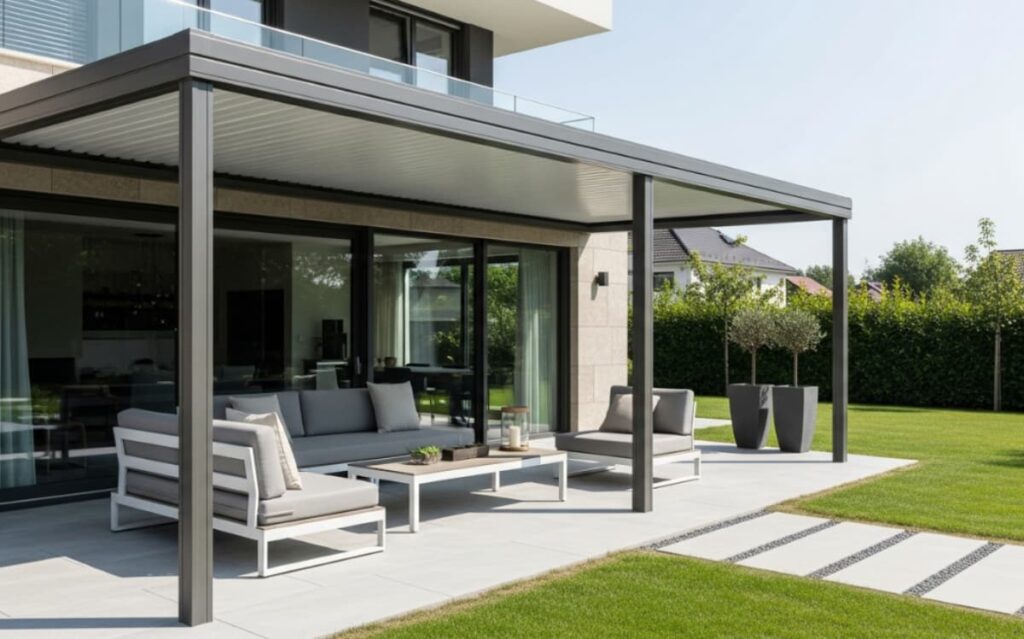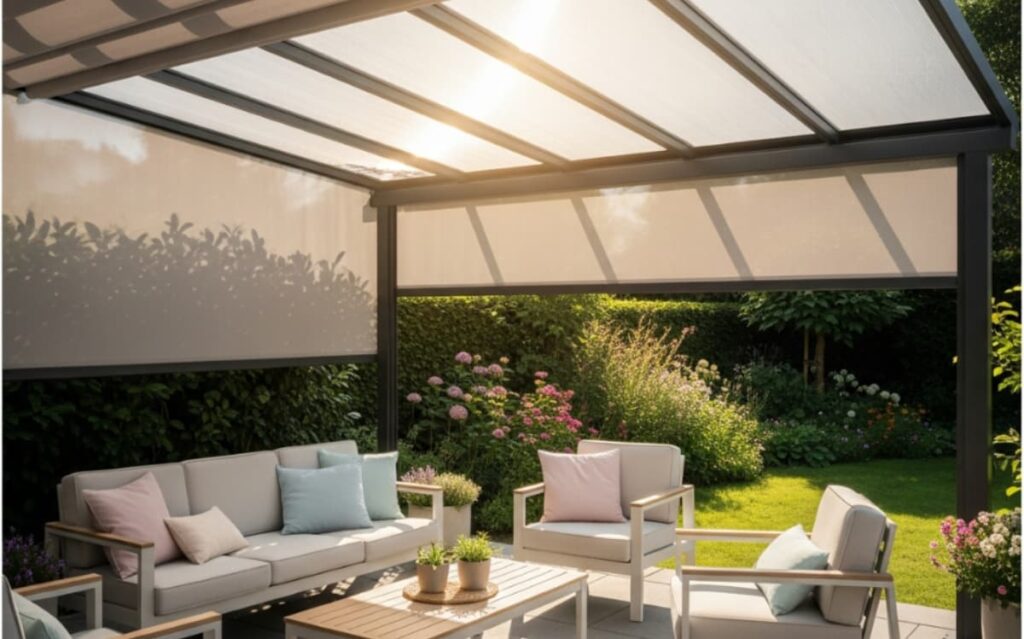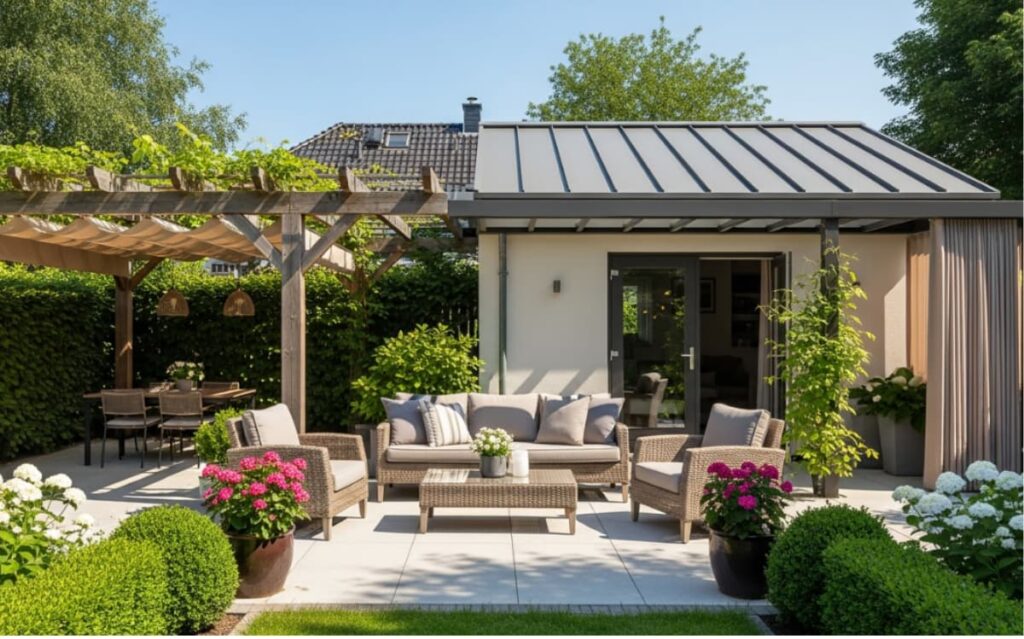Find the best material for your patio cover. Our guide compares aluminum, wood, vinyl, and more to help you choose based on your climate, budget, and maintenance.
Trying to pick a material for a new patio cover can get overwhelming fast. You’ve got aluminum, wood, vinyl, and a bunch of other options.
The truth is, there’s no single “best” one, it all depends on the weather where you live, how much you want to spend, and the look you’re going for. This is just a straight-up guide to help you figure out which one makes the most sense for your backyard.
The Main Takeaways
- The material is a big deal. It’s the difference between a cover that lasts for decades and one that’s a headache after a few years.
- Weather is boss. What works in a hot, dry climate will get destroyed in a place with heavy snow. You have to choose for your location.
- It’s a balancing act. You’re trying to find the sweet spot between your budget, the style you want, and how much maintenance you’re willing to do.
Why This Choice Matters

This is about more than just a roof. The material you pick determines how much time you spend enjoying your patio versus how much time you spend working on it. A good cover that’s right for your home turns your backyard into a place you actually want to be, a cool spot in the summer, a dry place during a drizzle. Getting this one decision right makes all the difference.
What to Think About First
Before you start looking at pictures and falling in love with a certain style, just think through these few things. It will save you a lot of trouble later.
First, Your Local Weather
This is the most important part. If you get a ton of scorching sun, you need something that won’t fade or crack. If you get heavy snow, you need something strong enough that you’re not worrying about it collapsing. High winds, salty air, tons of rain, your patio cover has to live with this stuff 24/7. So, start with what your weather is like.
Next, Be Honest About Upkeep
Do you enjoy spending a Saturday working on the house, or would you rather be doing literally anything else? Some materials, like aluminum [1] and vinyl, are about as low-maintenance as it gets. You just hose them off.
Wood, on the other hand, looks amazing but you’ll have to stain or seal it every few years. There’s no right answer, but you have to be honest with yourself about how much work you’re willing to put in.
Making Sure It Looks Good
You want your new cover to look like it’s always been a part of your house. Wood can give you that classic, rustic feel. Metal can look sleek and modern. Just take a look at your home’s style and think about what would fit its vibe.
And of Course, the Budget
Budget is always part of the conversation. Some materials are cheaper upfront, but they might not last as long. A more expensive material might save you money in the long run because you won’t have to repair or replace it. Try to think about the long-term value, not just the initial price tag.
Breaking Down the Materials

Alright, let’s get into the actual options. Here’s the thing on each one.
Aluminum: The No-Worry Option
If you’re the kind of person who wants to get something done and then never think about it again, aluminum is probably for you. It’s tough, it lasts forever, and it won’t rust. You can get it in pretty much any color, too. The only real downside is that some people think it looks a bit plain compared to wood, and you can definitely hear the rain on it. But for a hassle-free cover, it’s hard to beat.
Wood: The Classic Look
For that warm, traditional backyard feel, nothing beats wood. It just looks great and feels inviting. Cedar and redwood are top choices because they naturally resist bugs and rot. But, and this is a big but, wood is a commitment. If you don’t stain or seal it regularly, the weather will take its toll. It’s the best choice for looks, but only if you’re prepared for the upkeep.
Vinyl: The Budget-Friendly Choice
If you want a simple, clean-looking cover and don’t want to spend a ton of money, take a look at vinyl. It’s easy to clean, it’s affordable, and it handles normal weather just fine. It’s not as strong as aluminum or wood, so if you get really heavy snow or high winds, it might not be the best choice. But for most moderate climates, it’s a really practical, cost-effective option.
Steel: The Heavy-Duty Option
If you live somewhere with serious weather, we’re talking feet of snow or hurricane-force winds, you need to think about steel. It is incredibly strong and will give you total peace of mind. Because it’s so heavy, it needs a very solid frame to support it, and it’s more expensive. But when you absolutely need strength, steel is the answer.
Polycarbonate: The “Sun, but Not Too Much Sun” Option
Ever seen those translucent covers that let a soft light through? That’s usually polycarbonate [2]. It’s a great way to keep your patio bright and sunny without getting blasted by direct sun and harmful UV rays. It’s tough, but it can get scratched, and it can trap a little heat. It’s a great middle-ground if you don’t want a dark, shady space.
Fiberglass: The Last Cover You’ll Ever Need
Think of fiberglass like the hull of a boat, it’s made to be incredibly tough and completely ignore the weather. It won’t rot, rust, fade, or crack. You put it up, and it will likely outlast the rest of the house with zero maintenance. It’s a premium material, and it has a higher price tag, but it’s the ultimate choice if you want to do it once and do it right.
Fabric: The Stylish, Casual Option
For a more relaxed, flexible approach, you have fabric awnings and shade sails. They’re great for adding a pop of color and style, and they let air flow through, which is nice in hot climates. The trade-off is durability. They need to be cleaned, and they’ll eventually wear out from sun exposure, so you’ll have to replace them every 5 to 10 years.
So, How Do You Choose?

After all that, how do you actually decide? Just ask yourself these questions:
- What can my local weather destroy?
- How much work am I actually going to do on this thing?
- What’s my real budget, for the long haul?
- What look am I going for?
One of the materials above will probably feel like the obvious answer.
Frequently Asked Questions
Can I hang things like fans or lights from my new patio cover?
Yes, you can, but it is very important to plan for this from the beginning. When you are selecting the right material for your patio cover, you need to think about the extra weight. The best patio cover material for hanging heavy items is often an aluminum patio cover because it can be built with extra support beams.
You have to tell your patio cover contractor what you want to hang so they can plan for a safe professional installation. This is a key step to creating the perfect patio cover for your outdoor living space.
Why is hiring a professional patio cover contractor so important?
Hiring a professional patio cover contractor is a huge part of a successful project. They make sure the patio cover installation is safe and follows all the local rules. A good contractor is also a big help in choosing the best patio cover for your home’s style and needs.
A professional installation by an experienced patio cover contractor ensures your new outdoor living space is built to last and avoids costly mistakes, making the process to get your perfect patio cover much easier.
What should I look for in a patio cover for a very hot and sunny climate?
For a hot climate, the most important things are shade and protection from the sun. The best materials for patio covers in sunny areas are materials that block heat effectively. Insulated aluminum patio covers are an excellent choice. Another great patio cover material to consider is polycarbonate panels because they block harmful UV rays.
Selecting the right material is the key to creating a comfortable outdoor living space. You should also think about the maintenance requirements, as you want something with durability and low maintenance.
Is an aluminum patio cover always more expensive than wood?
Not necessarily, especially when you think about the future. The starting price for a quality aluminum patio cover can sometimes be more expensive than wood. However, the real cost difference shows up over time.
A wood structure has high maintenance requirements, needing regular sealing and repairs. An aluminum structure has great durability and low maintenance. Because you won’t be spending money on upkeep, aluminum patio covers are often the better long-term investment when choosing the best patio cover material.
How long will my patio cover installation take from start to finish?
The time needed for a professional installation depends on the patio cover materials you select. A standard aluminum patio cover installation can be very quick, often taking just a couple of days for a patio cover contractor to complete.
If you choose a more custom design or a different patio cover material, it might take a week or more. Your patio cover contractor should give you a clear timeline before they start working on your new outdoor living space.
We Can Help Make It Happen
We know this is a lot to think about. At Lapis Patios, our job is to help you sort through these options and find the right fit for your home and your budget. We handle all the tough parts of the job, the construction, the permits, and making sure it’s built to last.
If you’re ready to talk about your project, we’d be happy to help. Contact Lapis Patios today for a free consultation, and we can walk you through everything with no pressure.
References
- https://www.gsa.gov/real-estate/historic-preservation/historic-preservation-policy-tools/preservation-tools-resources/technical-procedures/aluminum-characteristics-uses-and-problems
- https://en.wikipedia.org/wiki/Polycarbonate

